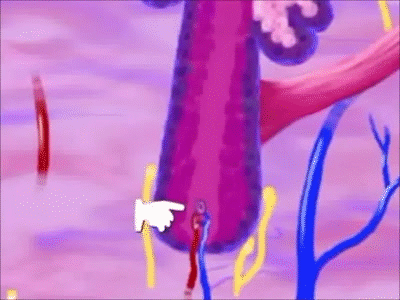Hair, nails, skin, and endocrine glands (sweat and oil) are all apart of this system. Primarily works to protect body from the environment surrounding it. The pathogens of disease are the main problem of the environment for the body. The integumentary system works in concert with all other bodily systems. The skin protects the organs and tissues. Keeps out dangerous organisms. Helps to create a stable temperature, and keep body hydrated. It stores nutrients, also (vitamins and lipids) and disposes of waste. The integumentary system is responsible for one being able to have the sense of touch, feel pain, changes in temperature, and pressure. The skin also is apart of the immune system which can secrete oil as an extra obstacle for pathogens. Melanin and vitamin D are secreted by the skin. In turn water, urea, milk, and salts are excreted. Calcium is needed from the digestive system to synthesize protective oils on the skin.

Arrector pili muscle: small muscles attached to hair follicles
Cutaneous nerve: provides sensory innervation to the skin
Dermal papilla: nourish all hair follicles and bring nutrients and oxygen to the lower layers of epidermal cells.
Dermis: thick layer of living tissue below the epidermis that forms the true skin, containing blood capillaries, nerve endings, sweat glands, hair follicles, and other structures.
Hair follicle: sheath of cells and connective tissue that surrounds the root of a hair.
Hair root: part of the hair below the surface of the skin.
Hair shaft: living cells divide and grow to build
Meissner corpuscle: located in the skin that is sensitive to light touch and vibration
Pacinian corpuscle: an encapsulated ending of a sensory nerve that acts as a receptor for pressure and vibration.
Papilla of hair: an indentation at the base of the bulb of the hair.
Sebaceous gland: a small gland in the skin which secretes a lubricating oily matter (sebum) into the hair follicles to lubricate the skin and hair.
Stratum basale: deepest layer of the five layers of the epidermis, continuous layer of cells.
Stratum corneum: the horny outer layer of the skin.
Stratum granulosum: a thin layer of cells in the epidermis. (granular layer.)
Stratum spinosum: spinous layer/prickle cell layer) is a layer of the epidermis found between the stratum granulosum and stratum basale.
Subcutaneous layer: for fat storage. A layer of tissue lies immediately below the dermis of vertebrate skin.
Sweat gland: a small gland that secretes sweat, situated in the dermis of the skin. Such glands are found over most of the body, and have a simple coiled tubular structure.
Sweat pore: the surface opening of the duct of a sweat gland.

https://www.google.com/url?sa=i&rct=j&q=&esrc=s&source=images&cd=&cad=rja&uact=8&ved=0ahUKEwjtmoL26d7TAhVPImMKHVwUCREQjhwIBQ&url=https%3A%2F%2Fwww.pinterest.com%2Fpin%2F426927239648419681%2F&psig=AFQjCNFM8VJys6eLKOGgcqT5lBkWl9RhVg&ust=1494282391159023
https://i.makeagif.com/media/3-03-2015/U9KF-0.gif
No comments:
Post a Comment